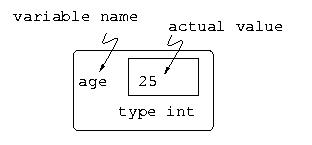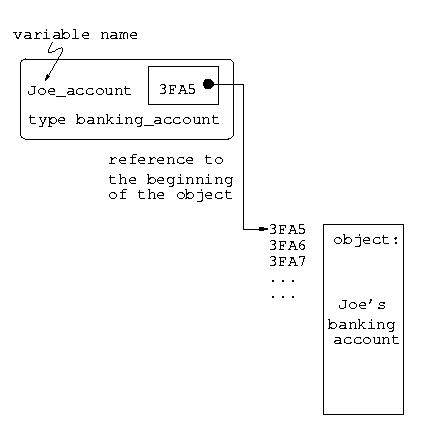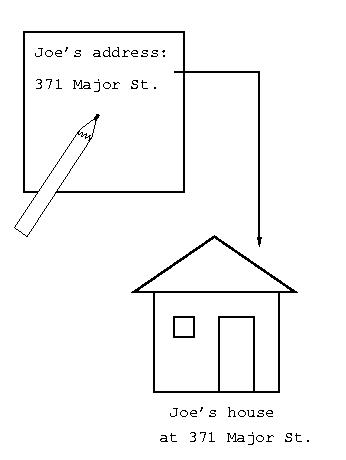Variables are the nouns of a programming language-that is,
they are the entities (values and data) that act or are acted upon.
A variable declaration always contains two components:
-
the type of the variable and
-
its name.
For example, "int count;" has type integer
and name "count".
All variables in the Java language must have a data type. A variable's
data type determines the values that the variable can contain and the operations
that can be performed on it. For example,
|
values it can contain |
operations which can be performed on it |
| Integer |
integral values
(both positive and negative) |
standard arithmetic (+, -,
*, / and %) |
Integers can contain only integral values (both positive and negative),
and you can use the standard arithmetic operators (+, -,
*,
/ and %) on integers to perform the standard arithmetic operations (addition,
subtraction, multiplication, and division, respectively).
Operator / and %: The operator / is the division operator, and
% is the remainder operator. For example,
int i =17 / 3; // The result
is 5
int i = 17 % 3; // The result is 2, which is the remainder after
the division.
There are two major categories of data types in the Java language:
primitive
and reference.
Which primitive types should you know?
The following table lists, by keyword, some of the primitive data types
in Java which you should know, their sizes and formats, and a brief description
of each.
| Type |
Size/Format |
Description |
| (integers) |
| int |
32-bit two's complement |
Integer |
| (real numbers) |
| double |
64-bit IEEE 754 |
Double-precision floating point |
| (other types) |
| char |
16-bit Unicode character |
A single character |
| boolean |
true or false` |
A boolean value (true or false) |
Numbers
Numbers come in various favours, but the most important classification
is: does it have a fraction?
-
For fractional numbers, use the type double --
double radius = 50.4;
double length = 4.0;
Rahter than writing
people normally write this kind of number using scientific notation, such
as,
(i.e., 3.86 times 10 to the power of 8). Since superscripts are traditionally
not easy to print, the power of 10 is represented by the letter E
followed
by the value of the exponent:
To distinguish double from int literals, double literals with no
decimal point or exponent (i.e., those that look like int literals) must
have a trailing d, as, for example,
-
for non-fractional, use int --
There are times when this advice will be wrong, but at this point in your
career, you shouldn't be worrying about those times.
Characters
-
Characters are represented by the type char.
-
Each char represent a single character. For example:
-
Strings are made up of characters: the value of
is 'h'.
-
characters can be treated as a sort of number. You can write
but you don't get 'j'; instead, 'h'+2 is some number you are really not
interested in. To get 'j', write
-
Remember two rules:
-
'a' ... 'z', 'A' ... 'Z', '0' ... '9' are each in order and contiguous.
-
' ' (the blank) is a character and comes "before" all other printable characters.
Booleans
-
Booleans represent "truth values" and can only have the values true
and
false.
-
Most Often, you use booleans without explicitly declaring a variable of
the boolean type. For example, the expression
is actually boolean, and has the value true
if the variable "number" contains a value less than 0, and
false otherwise.
As we will see, we would seldom declare a boolean variable to
contain the result; instead, we would use it inside a statement somehow.
-
One thing you will find yourself needing is combinations of booleans in
expressions like these:
|
operator |
example expression
|
expression evaluates to ...
|
| Logic AND |
&&
|
(number > 0) && (number < 100) |
true, if
the first condition and the second condition are both satisfied;
false, otherwise. |
| logic OR |
||
|
(number < 0) || (sum < 100) |
true,
if
either the first condition or the second condition (or both) are satisfied;
false, otherwise. |
| equality |
==
|
object1 == object2 |
true,
if object1 is the same as object2;
false, otherwise. |
| inequality |
!=
|
object1 != object2 |
true,
if object1 is not the same as object2;
false, otherwise. |
Purity Tip: In other languages, the format and size of
primitive data types may depend on the platform on which a program is running.
In contrast, the Java language specifies the size and format of its primitive
data types. Hence, you don't have to worry about system-dependencies.
Sometimes, we would like to work with different data types.
Different data type has different formats/sizes. For instance, char,
int and double are 16-bits, 32-bits and 64 bits, respectively. The
convertion from one data type to the other has to follow ceratin rules.
Promotion Rule
The promotion rules specify how types can be converted to other
types without losing data. For example, an int is automatically converted
to a double without changing its value. However, a double converted
to an int trucates the fractional part of the double value.
The promotion rules apply to expressions containing values of two or
more data types; such expressions are also referred to as mixed-type expressions.
The type of each value in a mixed-type expression is promoted to the "highest"
type in the expression (actually a temporary version of each value is created
and used for the expression -- the original values remain unchanged).
The table below lists the primitive data types (boolean, char, int, double)
and the types to withch each is allowed to be promoted automatically.
| Type |
Allowed promotions |
| double |
None (there are no primitive types larger than double) |
| int |
double |
| char |
int, double |
| boolean |
None (boolean values are not considered to be numbers in Java) |
Casting
If you have
double d = 3.14;
int i = d; // this is WRONG!!
The compiler will complain that "this is an illegal assignment".
Becuase a double number has 64-bits whereas an integer (int) has only 32
bits, i.e., a double stores more information than an int.
Converting values to lower types can result in incorrect values.
Therefore, in cases where information may be lost due to conversion, the
Java compiler requires the programmer to use a cast operator to force the
conversion to occur.
For example, assigning the double
double d = 3.1415926;
to an int type variable
int i;
we would lose accuracy. So we have to do the conversion explicitly
by telling Java that we want to convert the double to an int --
i = (int) d;
// now i is 3
Java will make a copy of d, truncate the fractional part of number, and
assign the result to i.
Here are some more examples of casting lower types (less bits in its
format/size) to
There are two major categories of data types in the Java language:
primitive
and reference.
Primitive Data Types
A variable of primitive type contains a single value of the appropriate
size and format for its type: a number, character, or boolean value.
For example, the value of an int is an integer, the value
of a
char is a 16-bit Unicode character, and so on.

Reference Data Types
Arrays, classes, and interfaces are reference types.
The value of a reference type variable, in contrast to that of a primitive
type, is a reference to the actual value or set of values represented by
the variable.
A reference is like your friend's address: The address is not your friend,
but it's a way to reach your friend. A reference type variable is not the
array or object itself but rather a way to reach it.

This is like -- knowing the address of Joe's house, we can locate Joe's
house.
The addressis a reference to Joe's house, not the actual object.

|
Example type |
The variable stores... |
| Primitive Data Type |
int, double, char, boolean |
the actual value |
| Reference Data Type |
class, array, interfaces |
a reference (like an address) |
The countChars method uses one variable of reference type,
in,
which is a Reader object. When used in a statement or expression,
the name in evaluates to a reference to the object. So you can
use the object's name to access its member variables or call its methods
(just as countChars does to call read).


